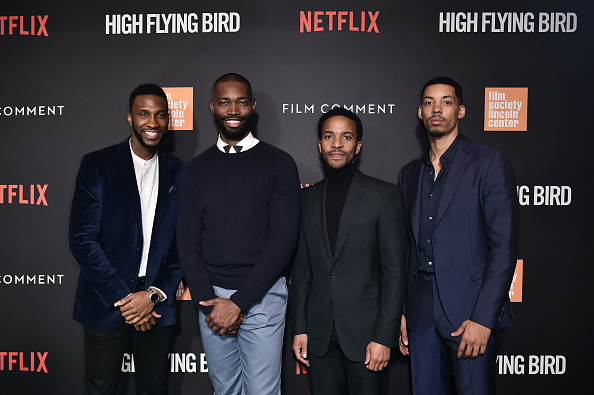High Flying Bird is the latest film from director Steven Soderbergh and the first of two films that he will release through Netflix in 2019. For those that haven’t been following his career, we are in the middle of a Soderbergh renaissance after his supposed retirement in 2013. He came back onto the scene with his 2017 heist film, Logan Lucky, and then followed up a few months later with the psychological horror film, Unsane. They went on to become two of the most critically well-received films of his career. Can he make it an official hot streak with High Flying Bird?
High Flying Bird Review
A Different Kind of Heist Film
Without giving too much away, High Flying Bird revolves around sports agent, Ray Burke (André Holland), and his client, Erick Scott (Melvin Gregg), as they navigate the turbulent waters of an NBA lockout. At the surface, it is a particularly fascinating look at the business side of basketball and the complicated nature of lockouts. However, there is much more to this film than the simple premise at the start of this paragraph. This is a densely layered film that packs a lot of information and ideas into its slim, 90-minute frame.
Taking inspiration from the 2011 NBA lockout that lasted 21 weeks, this film delves into the issue of the inequality of revenue distribution between owners and players in professional sports. As part of the terms to end the 2011 lockout, a nearly 50/50 split of the revenue share was agreed upon by the players association and the owners. The film brings this revenue split to light and points out the unfairness of it due to there being many more players in the league than there are owners. This 50/50 revenue split becomes the main point of contention in the new lockout presented in this film.
From Out of Sight, to the Ocean’s trilogy, to Logan Lucky, it’s clear that Soderbergh has long had an affinity for heist films. Even though this isn’t truly a heist film at its surface, its shared theme of taking from the rich makes it a different kind of caper. One where the heist occurs in the form of contract negotiations and the fight for leverage, rather than sneaking around a highly guarded facility and trying to reach the extraction point undetected. More importantly, it’s a film that introduces some intriguing ideas regarding the business end of sports, the nature of the owner/player relationship, and where the power truly lies.
Steven Soderbergh’s iPhone Phase Continues
If you haven’t heard by now, Steven Soderbergh’s 2018 psychological horror film, Unsane, was filmed entirely on an iPhone. The narrow lens of the iPhone and the frequent use of close up shots really added to the claustrophobic feel of that film, an aesthetic that is extremely useful to have in a film about being trapped in a mental health facility. As a result, the audience was more drawn in, the horror was more effective, and the film as a whole was elevated. While the story of Unsane lent itself to this experimental style of filmmaking, the same can’t really be said for High Flying Bird. There was really no need here for the visual aesthetic that the iPhone provides. The 90-minute runtime, combined with the limitations of shooting an iPhone, made this film feel much smaller than the ideas it brought to the table.
Filming on an iPhone isn’t suitable for much more than small, interpersonal conversations. This film consisted almost entirely of just that, albeit with fascinating dialogue, utilizing plenty of close-ups and the occasional wide shot. While Soderbergh did a fantastic job bringing forth grander themes that existed within the narrative, the filmmaking, and ultimately the story, was much more contained than it needed to be. The run time had every right to push two hours and the scope of the story had every right to push past the more intimate and personal feel that shooting on an iPhone creates.
Limitations aside, what Soderbergh did with this film was still impressive. There is no reason this film should have worked being shot on an iPhone but somehow he pulled it off. Tarell Alvin McCraney’s script brings ideas to light that will sit with the viewer long after the credits roll. If nothing else, Soderbergh’s minimalist style let those ideas shine without cluttering the film with extra fluff. The decision to intersperse interviews with real NBA athletes made the character of Erick Scott feel that much more authentic, which helped my investment in the film as a whole.
Last Word on High Flying Bird
Steven Soderbergh’s latest film, and second in a row to be shot on an iPhone, is a gripping drama revolving around an NBA lockout and the struggle for leverage. While the scope of the film is frustratingly limited by the decision to shoot on an iPhone, the story was still complex and the ideas presented within that story were fascinating. There is a lot to digest in its lean, 90-minute, run time which ensures that this film flies by. It’s rare that I ever say this but this film could have, and should have, been longer. Despite the iPhone aesthetic being an ill fit, this still manages to be the better of the two films of the Soderbergh iPhone era and may just be the best film he’s put out since coming out of retirement.
4/5 Stars
Main Image Credit:
Embed from Getty Images

